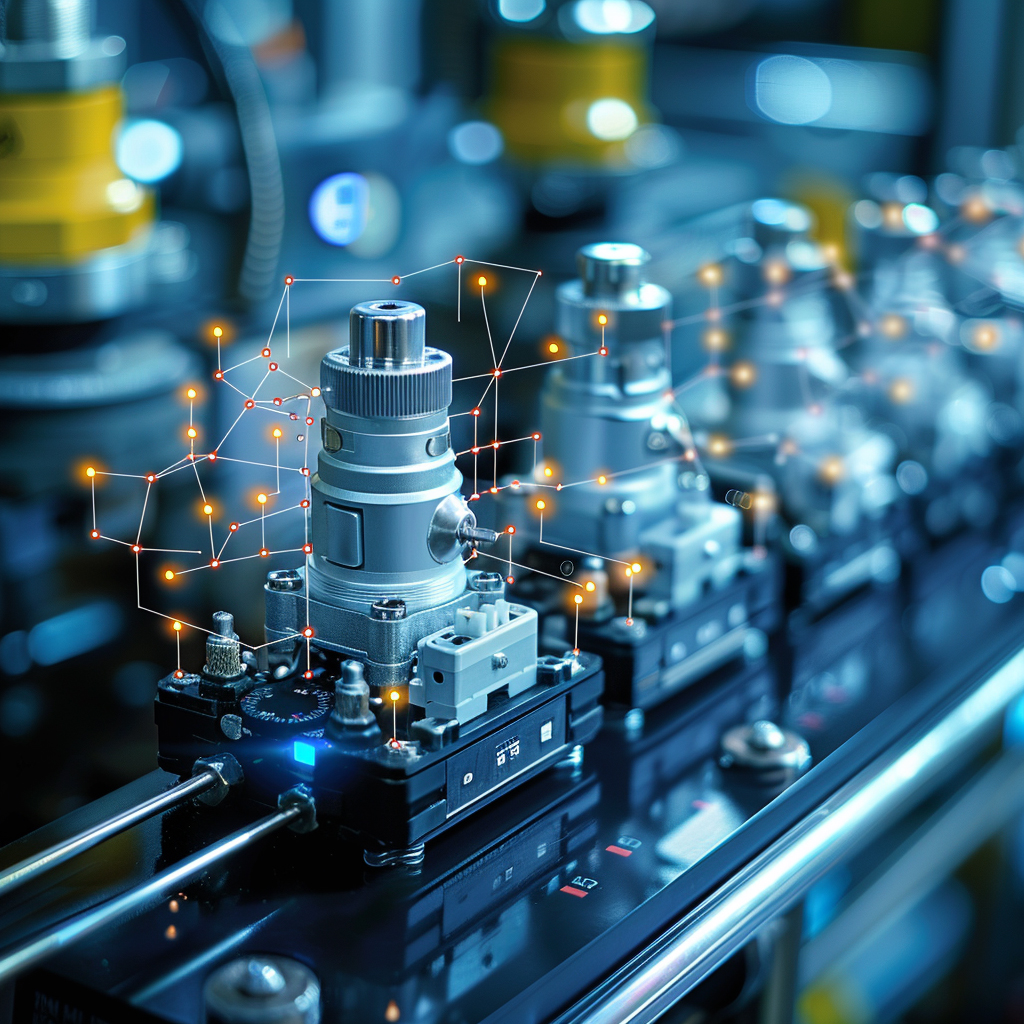1. Advanced Data Processing
AI algorithms are capable of ingesting and analyzing massive datasets far faster and more efficiently than traditional data processing methods. By automating complex data parsing and pattern recognition tasks, AI can uncover subtle correlations and trends that human analysts might miss. This advanced data processing power enables organizations to leverage unstructured and high-volume data (such as text, images, or sensor streams) that were previously too cumbersome to analyze. In practice, this means businesses can derive insights from a wider array of data sources, leading to more informed strategic decisions. Ultimately, AI-driven data processing reduces the manual effort and time required for analysis, allowing teams to focus on interpretation and action rather than data wrangling.

Nearly half of businesses are already using AI and machine learning tools to handle big data, underscoring AI’s pivotal role in modern analytics. For example, 48% of companies report using some form of AI to utilize large datasets effectively. This widespread adoption reflects how essential AI has become for managing the volume, variety, and velocity of today’s data. By processing information at scale, AI not only accelerates insight generation but also maintains higher data accuracy and consistency than manual methods.
2. Real-Time Predictions
AI enables real-time predictive analytics by continuously processing incoming data streams and updating forecasts instantaneously. This capability is crucial in fast-paced environments – for instance, financial markets or emergency response – where conditions can change in seconds and quick decisions are vital. By analyzing live data feeds (such as transaction records, sensor outputs, or social media trends), AI systems can alert decision-makers to emerging patterns or anomalies as they happen. The practical impact is that organizations can respond proactively rather than reactively: inventory can be reallocated before a stockout, or interventions can be launched as a crisis unfolds. Real-time AI predictions thus provide a competitive edge by reducing lag between insight and action, helping businesses and services stay agile and responsive.

The business value of real-time AI predictions is evidenced by significant performance gains reported across industries. In one multi-country industry survey, 80% of companies saw increased revenues after implementing real-time data analytics, collectively realizing an estimated $2.6 trillion in additional revenue across those firms. Moreover, nearly all surveyed organizations noted improvements in customer satisfaction and efficiency when leveraging real-time insights. Such findings highlight how on-the-fly AI predictions can directly translate into financial and operational benefits, from capturing sales opportunities to cutting reaction times to market changes.
3. Increased Accuracy
AI-driven predictive models (especially those based on machine learning and deep learning) have markedly improved the accuracy of forecasts and classifications in many domains. By learning from vast amounts of historical data, these models discern complex, non-linear relationships between variables that traditional statistical methods might not capture. They also continuously refine their predictions as new data arrives, adjusting to recent trends or patterns. In practical terms, higher accuracy means fewer false alarms and missed detections – whether predicting customer churn, equipment failure, or disease risk. This leads to more reliable decision support: businesses can trust AI predictions to guide investments or interventions, reducing costly errors that come from inaccurate forecasts.

The use of AI can dramatically boost predictive accuracy – raising it from roughly 80% with traditional methods to over 98% when AI is applied. One analysis found that incorporating AI algorithms into predictive calculations increased average accuracy from 80.6% to 98.1%. This improvement of nearly 17.5 percentage points means AI-driven models are far better at hitting the mark, translating into millions of dollars saved or earned through more precise targeting, fewer mistakes, and optimized operations. Such precision is particularly valuable in high-stakes fields like finance (for credit risk scoring) or healthcare (for diagnostic predictions), where incremental gains in accuracy significantly improve outcomes.
4. Automated Model Adjustment
AI systems can automatically update and fine-tune their predictive models in response to new data or changing conditions, a process often referred to as continuous learning or AutoML (automated machine learning). Instead of requiring human analysts to periodically retrain models, modern AI can detect shifts in data patterns (for example, seasonal changes in demand or evolving customer preferences) and adjust its parameters on the fly. The practical impact is that predictive analytics remain accurate and relevant over time without manual intervention. For businesses, this means their forecasting tools and algorithms “stay fresh” and adaptive, even as markets or environments evolve. Automated model adjustment reduces maintenance overhead and helps prevent model drift (the degradation of model performance as real-world data diverges from training data), ensuring predictions remain trustworthy in dynamic contexts.

The growing reliance on automated model updates is reflected in the rapid expansion of the AutoML market. Globally, the Automated Machine Learning industry is projected to grow from about $1.1 billion in 2023 to $10.9 billion by 2030, at an extremely high compound annual growth rate (nearly 40% per year). This surge indicates that enterprises are investing heavily in tools that allow machine learning models to train, adjust, and deploy with minimal human oversight. By embracing these automated solutions, companies aim to scale up their predictive analytics capabilities quickly and keep models optimized continuously, which in turn yields more accurate forecasts and faster deployment of new predictive insights.
5. Anomaly Detection
AI excels at detecting anomalies – unusual patterns or outliers in data – that could indicate critical issues or opportunities. In predictive analytics, anomaly detection is used to identify events that deviate from the norm, such as fraudulent transactions, equipment malfunctions, or cybersecurity breaches, often before they fully manifest as problems. AI models can monitor vast streams of data in real time (from financial transactions to network logs or sensor readings) and flag irregularities with greater speed and sensitivity than rule-based systems. The practical impact is early warning: organizations can intervene promptly to mitigate risks, whether stopping a fraudulent credit card charge, fixing a machine that’s showing abnormal behavior, or isolating a network intrusion. By catching anomalies early, AI-driven predictive systems help avoid costly incidents, reduce downtime, and improve safety and security across various sectors.

Businesses that leverage AI for anomaly detection see substantial improvements in catching irregularities. For example, companies deploying AI-based fraud detection tools have experienced up to a 40% increase in fraud detection accuracy. This jump in accuracy means far more fraudulent activities are intercepted compared to traditional methods, significantly reducing financial losses and reputational damage. Similarly, in manufacturing, AI-based anomaly detection can identify signs of equipment failure well in advance, enabling preventive maintenance and reportedly cutting unplanned downtime nearly in half. These outcomes demonstrate how AI’s pattern-spotting prowess directly translates into better risk management and operational resilience.
6. Enhanced Customer Insights
AI-driven predictive analytics can deeply analyze customer behavior and preferences, yielding richer customer insights than traditional analysis. By examining purchase histories, browsing patterns, social media interactions, and demographic data, AI models identify trends and predict future customer actions (like likelihood to purchase, churn, or respond to a campaign). The practical impact is more effective marketing and customer experience strategies: companies can personalize product recommendations, tailor marketing messages to individual preferences, and time their engagements for when a customer is most receptive. These insights also help in segmenting customers into finer categories and forecasting lifetime value or churn risk, enabling proactive retention efforts. Overall, AI enhances customer understanding at scale, allowing businesses to build loyalty and increase satisfaction by anticipating needs and delivering highly relevant experiences.

Businesses are rapidly adopting AI to inform their marketing and customer relationship strategies. A recent survey reported that 53% of marketing leaders are already using or planning to use AI for predictive analytics aimed at understanding customer behavior and insights. In practice, this means over half of marketing decision-makers are leveraging AI to parse customer data and forecast trends such as purchasing patterns or attrition risks. The result has been more data-driven campaigns and product decisions, with many companies reporting improved customer engagement and conversion rates as a direct outcome of these AI-derived insights. This statistic highlights the industry shift toward embedding AI in marketing analytics to gain a competitive edge in customer intelligence.
7. Risk Assessment
In risk-heavy sectors like insurance, finance, and lending, AI improves risk assessment by evaluating a broader set of factors and scenarios than traditional models. AI-driven predictive analytics can ingest diverse data (financial history, market trends, customer behavior, even social and web data) to generate more nuanced risk profiles for individuals or assets. The practical impact is more accurate underwriting and pricing: for insurers, this means premiums that better reflect true risk, and for lenders, interest rates or credit approvals that are more finely tuned to an applicant’s risk of default. AI models can also run simulations of “what-if” scenarios, helping institutions foresee potential losses under various conditions (e.g., economic downturns). By quantifying risk with greater precision, organizations can both mitigate potential downsides (through reserves or preventive measures) and avoid unnecessarily conservative decisions, thus remaining competitive and profitable.

The financial and insurance industries are embracing AI at a rapid pace to enhance risk evaluation. In the insurance sector specifically, 77% of companies reported being in some stage of AI adoption in their operations by 2024, up from 61% in 2023. This dramatic increase, revealed in a survey of insurance executives, indicates a strong trust in AI’s ability to improve core risk assessment tasks like underwriting and fraud detection. Insurers using AI have noted more accurate risk scoring and faster processing of claims and applications. Similarly, banks using AI for credit risk analysis can consider more variables (like transaction patterns or online behavior), leading to a more accurate prediction of creditworthiness. The high adoption rates underscore AI’s perceived value in refining risk models and decision-making in these domains.
8. Predictive Maintenance
In manufacturing, energy, and other asset-intensive industries, AI-powered predictive maintenance is transforming how maintenance is conducted. By continuously monitoring equipment sensors and operational data (temperature, vibration, pressure, etc.), AI models can predict when a machine is likely to fail or require servicing. The key practical impact is that maintenance can be performed just-in-time – before a breakdown occurs, but not so early that it wastes resources. This approach prevents costly unplanned downtime and extends the lifespan of machinery by addressing issues at an optimal point. It also improves safety by reducing catastrophic failures. For example, instead of following a fixed maintenance schedule or reacting to a failure, a factory using AI might schedule a brief service stop for a generator that an algorithm flags as likely to overheat in the next two weeks. Overall, predictive maintenance optimizes operations: it boosts reliability, reduces maintenance costs, and minimizes disruptions to production.

Studies have quantified the significant benefits of AI-driven predictive maintenance. According to McKinsey research, IoT-enabled predictive maintenance (often powered by AI analytics) can cut maintenance costs by up to 30% and reduce unplanned equipment downtime by as much as 45%. These improvements come from fixing problems before they escalate and avoiding unnecessary routine maintenance. Additionally, by preventing major breakdowns, companies also extend equipment life (in some cases by 20% or more). For industrial operations, these percentages translate into substantial savings – potentially millions of dollars – and increased production capacity. For instance, fewer surprise line stoppages mean higher output and more consistent product delivery schedules. Such statistics make a strong case for the ROI of investing in AI-based maintenance systems.
9. Optimization of Supply Chains
AI is greatly enhancing supply chain optimization by improving demand forecasting, inventory management, and logistics planning. Traditional supply chain planning often struggles with volatility in demand and supply, but AI models can analyze historical sales, real-time market data, weather patterns, and even social trends to predict demand more accurately at a granular level. This means companies can stock the right products at the right locations, reducing both stockouts and excess inventory. AI can also optimize routing and distribution by factoring in dynamic variables (like current transportation network status or fuel prices) and making recommendations in real time. The practical impact includes lower holding costs, faster delivery times, and greater resilience to disruptions. For example, if an AI system foresees a spike in demand for a product next month, it can prompt manufacturers to ramp up production now and adjust warehouse allocations accordingly. In essence, AI brings a new level of precision and agility to supply chain management, translating into cost savings and improved customer service.

Analytics experts have observed major gains in forecast accuracy and efficiency when AI is applied to supply chains. A McKinsey analysis found that using AI-based forecasting in supply chain management can reduce demand prediction errors by 20–50%, which can lead to up to a 65% reduction in lost sales due to product unavailability. Better predictions ensure products are in stock when and where customers need them, directly boosting revenue and customer satisfaction. Furthermore, companies implementing AI in their supply chain report lower warehousing costs (inventory levels are optimized) and smoother operations, as the supply chain is less frequently caught off-guard by surprises. These statistics highlight that beyond incremental improvements, AI can fundamentally upgrade supply chain performance – making it more predictive, efficient, and responsive.
10. Healthcare Predictions
In healthcare, AI-driven predictive analytics is being used to anticipate patient needs and health trends, leading to more proactive and preventative care. Hospitals use AI models to predict patient admission rates and emergency department volumes, allowing them to allocate staff and resources in advance (for example, anticipating a surge in ER visits during a heatwave). Public health officials employ predictive analytics to forecast disease outbreaks by analyzing epidemiological data and even search engine queries or social media signals, enabling earlier interventions. Clinicians are also using AI to predict which patients are at highest risk of complications or readmission after discharge, so they can provide targeted follow-up and support. The practical impact is improved patient outcomes and operational efficiency: healthcare providers can prevent crises or manage them better, reduce avoidable hospital readmissions, and optimize the use of beds, equipment, and personnel. In short, AI allows healthcare systems to shift from reactive treatment to proactive management of health.

Concrete results in healthcare show the power of predictive analytics to improve outcomes and reduce costs. For instance, a large U.S. health system recently implemented an AI-based prediction tool to identify high-risk patients and tailor post-hospital care, which prevented 200 patient readmissions and saved an estimated $5 million in a single year. By forecasting which discharged patients were likely to bounce back to the hospital, care teams intervened with customized care plans and follow-ups, dramatically cutting the 30-day readmission rate. Similarly, other hospitals using AI predictive models have reported significant drops in complication rates and lengths of stay for certain conditions because issues are anticipated and managed earlier. These statistics illustrate how predictive analytics in healthcare not only benefits patients through better care but also produces substantial economic savings by avoiding costly acute episodes and penalties associated with high readmission rates.